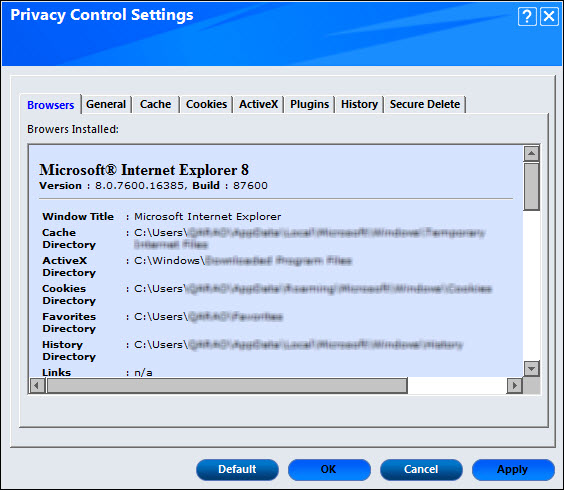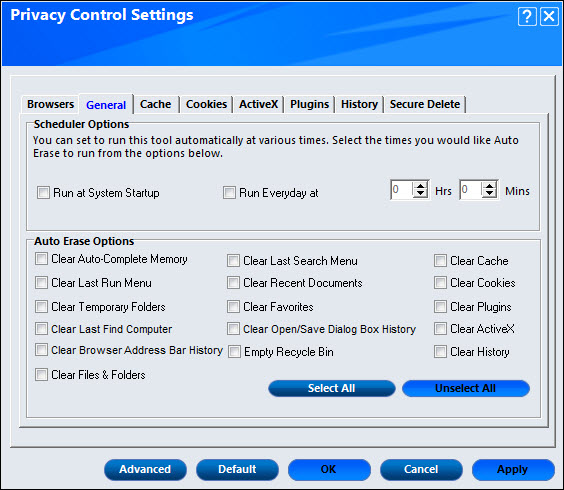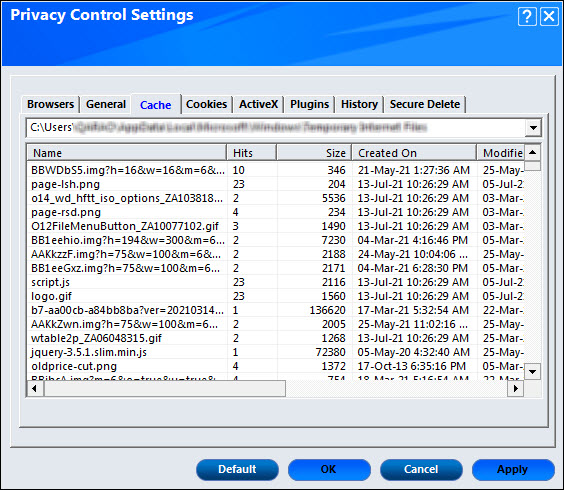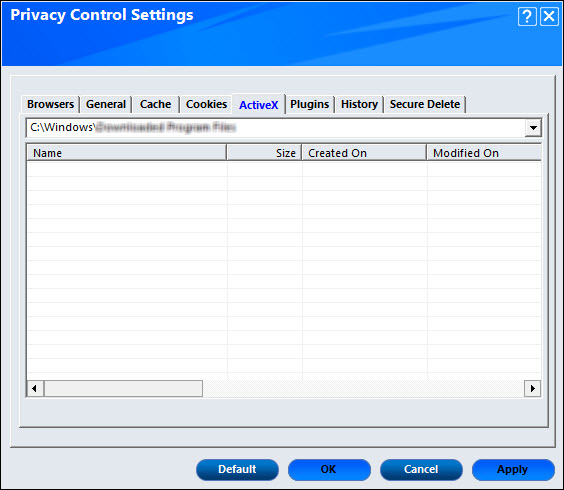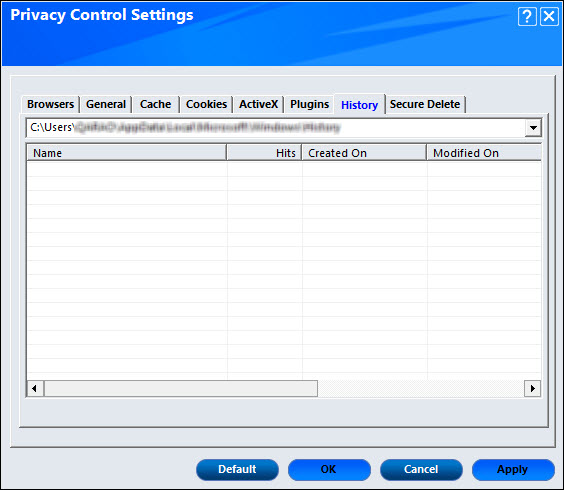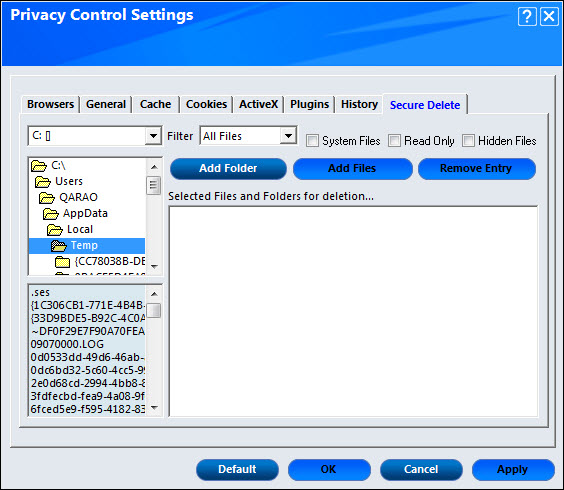From eScan Wiki
Contents |
Settings
Under Settings we have following tabs -- Browsers, General, Cache, Cookies, ActiveX, Plugins, History and Secure Delete. Lets see them in detail.
Browsers
This tab displays information regarding all the browsers installed on your computer.
General
This tab helps you specify the unwanted files created by web browsers or by other installed software that should be deleted.
You can configure the following settings:
- Scheduler Options: You can set the scheduler to run at specific time and erase private information, such as your browsing history from your computer. You can perform the following settings:
- Run at System Startup: This check box executes auto erase tool at system startup if selected. It automatically executes the Privacy Control module and performs the desired auto-erase functions when the computer starts up.
- Run Everyday at: This check box specifies the time at which you want auto erase tool to run. It auto-executes the Privacy Control module at a specified time and performs the desired auto-erase functions. The Hrs and Mins field is available only when you select Run Everyday at check box. Set the time in hours and minutes in appropriate boxes.
- Auto Erase Options: The browser stores traceable information of the websites that you have visited in certain folders. This information can be viewed by others. This option allows you to remove all traces of websites that you have visited. To do this, it auto detects the browsers that are installed on your computer. It then displays the traceable component and default path where the temporary data is stored on your computer. Select the following options based on your requirement:
- Clear Auto‑Complete Memory: Auto‑Complete Memory refers to the suggested matches that appear when you type text in the Address bar, the Run dialog box, or forms in Web pages. Hackers can use this information to monitor your surfing habits. When you select this check box, Privacy Control clears all this information from the computer.
- Clear Last Run Menu: This check box clears this information in the Run dialog box.
- Clear Temporary Folders: This check box clears files in the Temporary folder. This folder contains temporary files installed or saved by software. Clearing this folder creates space on the hard drive of the computer and boosts the performance of the computer.
- Clear Last Find Computer: This check box clears name of the computer for which you searched last.
- Clear Browser Address Bar History: This check box clears websites from the browser's address bar history.
- Clear Last Search Menu: This check box clears name of the objects that you last searched for by using the Search Menu.
- Clear Recent Documents: This check box clears names of the objects found in Recent Documents of your system.
- Clear Favorites: This check box clears Favorites added by the user in the computer.
- Clear Open/Save Dialog Box History: This check box clears the links of all the opened and saved files.
- Empty Recycle Bin: This check box clears the Recycle Bin. You should use this option with caution because it permanently clears the recycle bin.
- Clear Cache: This check box clears the all Temporary Internet Files in the system.
- Clear Cookies: This check box clears the Cookies stored by websites in the browser's cache.
- Clear Plugins: This check box removes the browser plug-in.
- Clear ActiveX: This check box clears the ActiveX controls.
- Clear History: This check box clears the history of all the websites that you have visited.
- Advanced: Click on Advanced Browser Cleanup Options popup appears. Select the required check box and close.
Cache
A cache is a hardware or software component that stores data so future requests for that data can be served faster; the data stored in a cache might be the result of an earlier computation, or the duplicate of data stored elsewhere. A cache hit occurs when the requested data can be found in a cache, while a cache miss occurs when it cannot. The cache tab displays the cache components such as name, hit, modified date, storage path, size, created date, and last accessed date.
Cookies
An HTTP cookie (also called web cookie, Internet cookie, browser cookie, or simply cookie) is a small piece of data sent from a website that is stored on the user's computer by the web browser while he/she is browsing. They can also be used to remember arbitrary pieces of information that the user previously entered into form fields such as names, addresses, passwords, and credit card numbers.
Cookies tab displays the cookie data such as name, hits, modified date, storage path, size, created date, expiry date, and last accessed date.
ActiveX
ActiveX is a framework for defining reusable software components (also known as ActiveX controls) in a programming-language independent way. Because ActiveX encapsulates specific functionality as ActiveX controls, it can be seamlessly incorporated into many software applications. The Internet Explorer web browser allows for ActiveX controls to be embedded into web pages. ActiveX controls officially run only in the Internet Explorer browser running on a Windows operating system.
This tab displays the ActiveX details such as name, modified date, storage path, size, created date, version, description, company name, comments, and last accessed date.
Plugins
When a program supports plug-ins, it enables customization. The common examples are the plug-ins used in web browsers to add new features such as search-engines, virus scanners, or the ability to use a new file type such as a new video format.
This tab displays all the Plugin details such as name, size, created date, modified date, storage path, and last accessed date.
History
This tab displays History details such as name, hits, created date, modified date, storage path, and last accessed date.
Secure Delete
This tab securely deletes files and folders present in the system. You can securely delete the added files and folders through Add Files and Add Folders button respectively. You can also remove the files and folder from Select Files and Folders for deletion.. list using Remove Entry button. You can apply filter for selecting the files and folders. You can filter folders based on the drives available and files based on text files, executable, icon files, shell links, URLs, images.
It also provides filter according to the following entity:
- System Files: This check box displays all the files and folders of the system.
- Read-only: This check box displays only read-only files and folders.
- Hidden Files: This check box displays all the hidden files and folders in the system.
|
NOTE |
At the bottom of the screen of all the tabs — Default, OK, Cancel, and Apply buttons are present that you can use after configuring the settings based on your requirement. |
Default
Click this button to apply the default settings.
OK
Click this button after you click the Apply button to apply the configured settings.
Cancel
Click this button to cancel the configured settings or to close the window.
Apply
Click this button to apply the configured settings.
